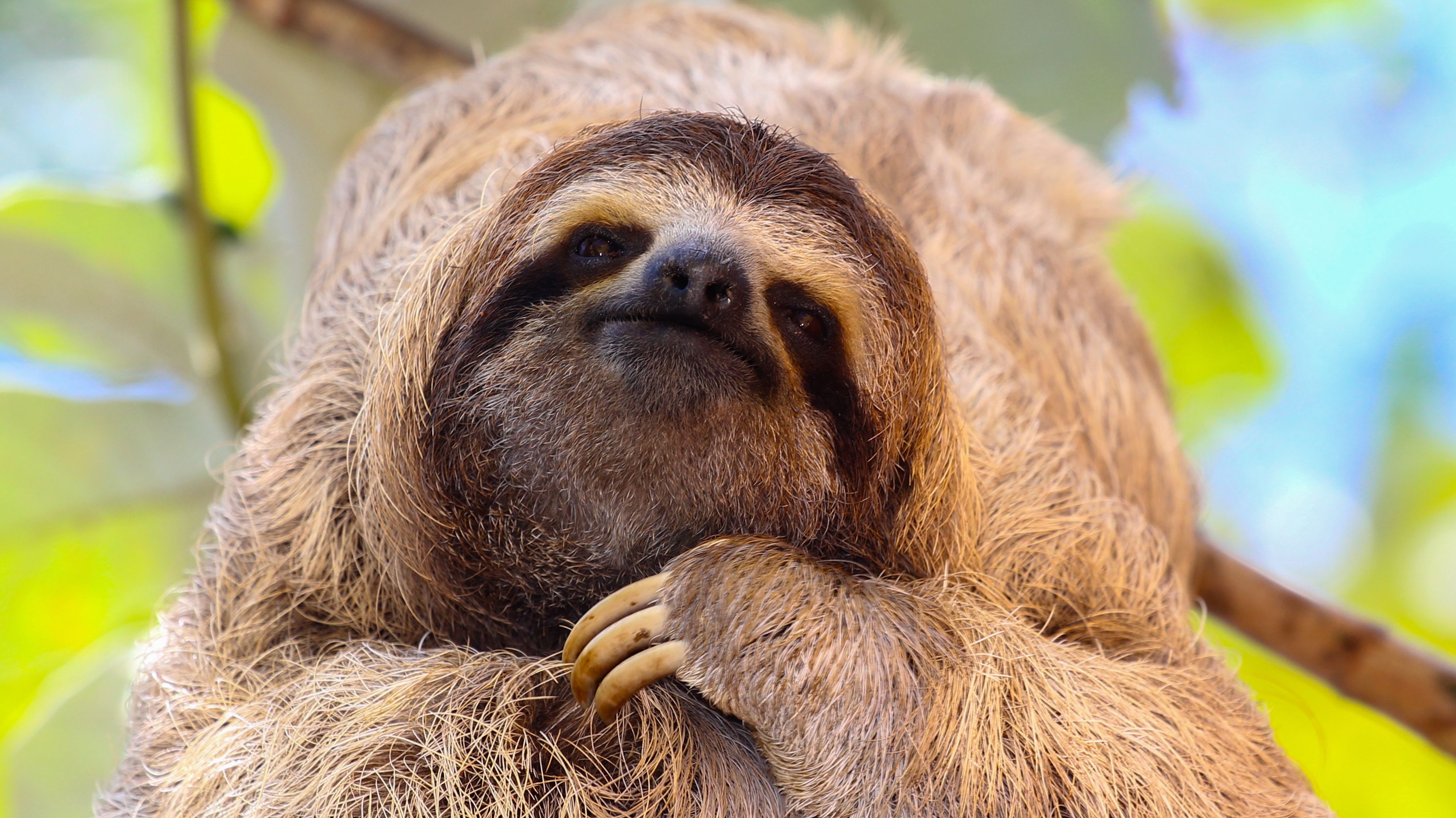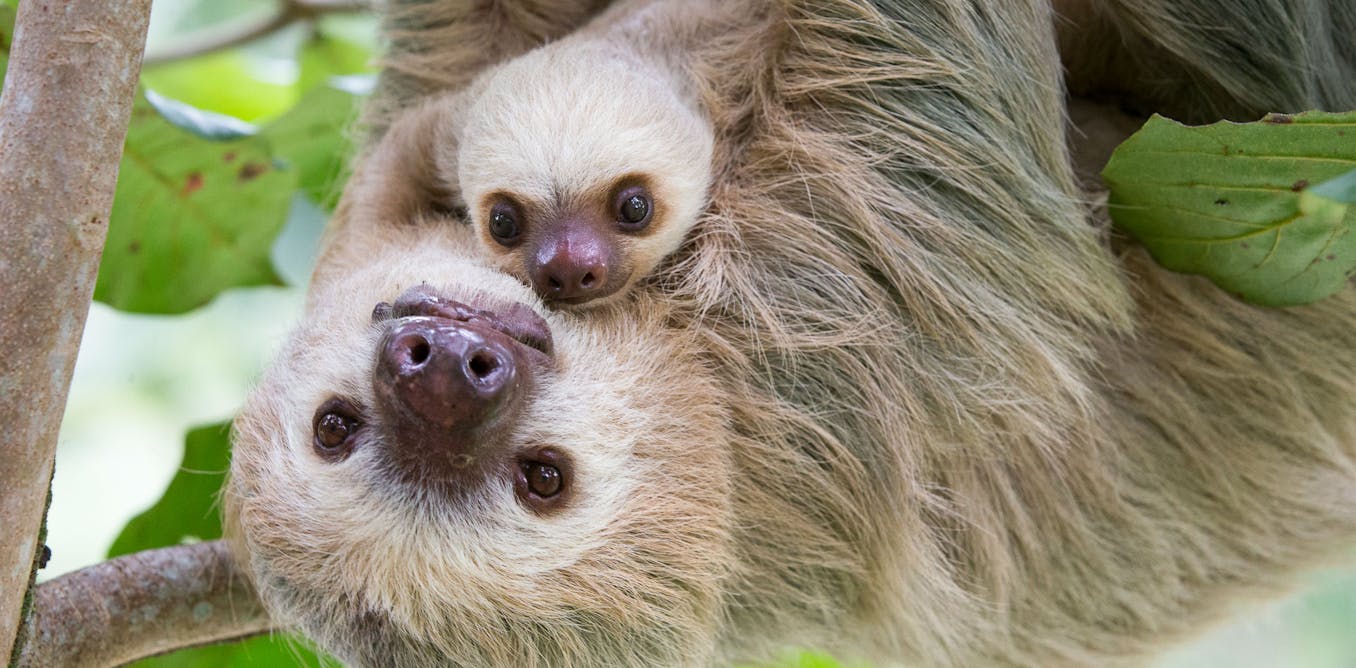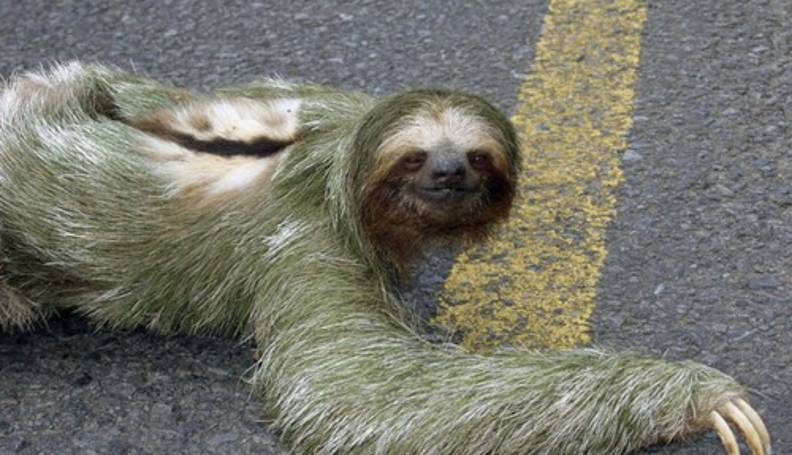How Sloths Move
How Sloths Move 6,1/10 875 votes
Sloths are mammals found in South and Central America. They hang to the tree branches with their long claws. They survive on leaves. Their long claws make it difficult for them to walk on the ground. Hence, they spend a lot of time on trees.
There are two kinds of sloths; Two-toed and three-toed. They share most of the features but vary in size.
Table of Contents
- 11 Sloths Characteristics
Sloths Facts and Information
There are six species of sloths—four species of three-toed sloths and two of the two-toed variety. Of those, only the two-toed species are frequently found in zoos. It comes down to an issue of. In the wild, two-toed sloths move more than 40 meters a day through the treetops, said Moore. Three-toed sloths move much less. The result: Two-toers have a more varied diet—enjoying everything. Has the gentle, lovable, adorable sloth always been a slow-moving, tree-dwelling creature? It may be difficult to imagine the sloth any other way (it sure is for me), but in today's article I am going to discuss evolution of sloths and will present some information that may surprise some people.
- Sloths are the slowest animals in the world.
- Algae grow on the fur of sloths. The green color of algae make sloths hide from predators in the trees.
- Sloths can climb only six to eight feet per minute.
- Sloths are wonderful swimmers. Sloths drop themselves into the water from the branches.
- Sloths do not shiver when it is cold as their body has only 25% muscle.
- The claws of sloths offer them protection against predators.
- The Scientific Name of the Sloths is Choloepus Hoffmanni
Sloths Diet
Sloths eat leaves which are hard to digest. The leaves are digested slowly in their four-part digestive system. A sloth takes a month to digest a meal of food. Their diet is not nutritious and they do not derive much energy from it.
Sloths are considered folivores as they rely on tender shoots, leaves and buds. Two-toed sloths have been found to eat small reptiles, birds and insects as per few documentations.
Sloths Habitat

Sloths are most commonly found in the rain forests of south and central America. They curl into a ball while sleeping. They also hang from the tree branches. Sloths are not known for activities.
They spend most of their time eating and sleeping. These leave trees only to swim. Sloths that have been kept captive sleep for fifteen to twenty hours per day. This leaves them with little time to indulge in social activities. Sloths prefer leading solo lives.
Sloths Appearance
Sloths have flat, short head, short snout, big eyes, long legs, tiny ears and curved claws. There are two species of sloths. These have either two or three claws. These have sad-looking eyes, stubby tails and roundish heads. Two toed sloths are bigger than the three toed ones. Three toed sloths seem as if they are smiling because of their facial coloring. Sloths can turn their head around because of the two extra vertebrae in the neck.
Behavior
Sloths spend a lot of time hanging from the branches of trees. They sleep, mate and eat in the trees. Their curved, strong claws help them in hanging from the branches of trees. Male sloths are shy, solitary animals. Female sloths indulge in little bit of socializing. They sleep entire day and are active during the night time. Sloths do not move until it is necessary. They defecate and urinate once a week and for this they come to the ground.
Sloths Lifespan
The life expectancy of a sloth varies based on the species. Most of the sloths live for 20 to 30 years. In captivity, there can survive for a longer time. The lifespan of a median sloth is 15 years.
Predators
Humans, the harpy eagle and jaguar are the main predators of sloths. Poachers and electrical lines were responsible for death of sloths in Costa Rica. A sloth can protect itself from camouflage and because of the slow movement. These features let them disappear in the canopy of the rainforest.
Sloths Breeding

Sloth mate and give birth to young ones in trees. Courting begins when a female sloth screams to inform the males in the area that she is ready for mating. Males put up a fight by hanging from the tree branches. They paw at other sloths to be the winner. Sloths just have one offspring at a time.
The gestation period is five to six months. The babies cling to their mothers for several weeks after their birth. They stay with their mothers for up to four years. The mating season is usually during the spring season. In South America, sloths mate during July-November. In Central America, the sloths mate during February-May.
Sloths Lifestyle
Sloths live in dense forests. They spend a lot of time in trees. They climb down once in a week to the base of the tree. They bury the feces in the vicinity of the trees they reside in. Their feces act as a wonderful fertilizer for the trees they reside in. This is because their stool breaks down quite easily.
Images, Pics, Photos and Pictures of Sloths :
Sloths Grooming
Sloths do not groom themselves. They have a dense coat of fur which grows algae. They have a greenish tinge during the rainy season because of the growth of algae. Sloths belly houses several micro bacteria for breaking down the food that they eat and thereby promote digestion.
The digestion process of a sloth is quite slow. It takes about a month for a slot to digest a meal. The metabolism of a sloth is very low. This is why the nutrients extracted from the sloths is slow and the low energy level probably the reason why they are sluggish.
Sloths Characteristics
- Sloths have greenish and thick brown coat of fur.
- They hand from trees with their claws.
- The only defense means for a sloth is its claw.
- A sloth that has been cornered tries to swipe the attackers to scare or wound them.
- Sloths move slowly and hence do not attract attention.
- They are vulnerable only during their visits to the ground that happens once in a week.
- Colonies of algae grow on sloths. This acts as a camouflage and source of nutrients when sloths try to lick their fur.
- In sloths, the hair grows in the opposite direction from other mammals. This is because they spend a lot of time with their legs above their bodies hanging from the tree branches. protection is offered to the sloths with their hair growing from extremities.
- Sloths are four legged animals
- Sloths land on the ground in upright position or else they spend most of the time up-side down hanging from tree branches
- Sloths are home to several creatures such as moths and beetles.
- Sloths are excellent swimmers.
- Sloths have multiple compartment stomachs.
Related Posts
- Aye Aye
The aye-aye is known as Daubentonia madagascariensis. It is a rodent like animal that can be found in Madagascar. Its features are similar to that of a rodent. The aye-aye…
- Red Panda
Red Pandas are popularly known as firefox, lesser panda, red bear cat and red cat bear. The size of these pandas is almost the same of a housecat, though their…
Sloths are medium-sized mammals that live in the Central and South American rainforests.
The sloth got its name from its slow movement, it is not lazy, just slow-moving. The sloth is the slowest mammal on Earth. In total, there are six species of sloth.
Sloths belong to the families ‘Megalonychidae’ and ‘Bradypodidae’, part of the order ‘Pilosa’. Most scientists call these two families the ‘Folivora’ suborder, while some call it ‘Phyllophaga’.
Family Bradypodidae

Genus (Three-toed sloths)
Pygmy Three-toed Sloth (Bradypus pygmaeus)
Maned Three-toed Sloth (Bradypus torquatus)
Pale-throated Three-toed Sloth (Bradypus tridactylus)
Brown-throated Three-toed Sloth (Bradypus variegatus)
Family Megalonychidae
Genus (Two-toed sloths)
Linnaeus’s Two-toed Sloth (Choloepus didactylus)
Hoffmann’s Two-toed Sloth (Choloepus hoffmanni)
Sloth Characteristics
Sloths have a thick brown and slightly-greenish fur coat and are about the size of a cat around 2 feet (61 centimetres) long. Sloths have a short, flat head, big eyes, a short snout, a short or non-existent tail, long legs, tiny ears and sturdy, curved claws are on each foot. They use these claws to hang from trees. Sloths claws serve as their only natural defence. A cornered sloth may swipe at its attackers in an effort to scare them away or wound them. Despite the sloths apparent defencelessness, predators do not pose special problems. In the trees sloths have good camouflage and moving only slowly, do not attract attention. Only during their rare visits to ground level do they become vulnerable.
Some sloths have colonies of green algae encrusting their fur, both adding to the camouflage effect and providing some nutrients to the sloths, who lick the algae during grooming. Sloth fur exhibits specialized functions. The outer hairs grow in a direction opposite from that of other mammals. In most mammals, hairs grow towards the extremities, but because sloths spend so much time with their legs above their bodies, their hairs grow away from the extremities in order to provide protection from the elements while the sloth hangs upside down.
Sloths are quadrupeds (four-legged animals) who ‘walk’ upside-down along tree branches. Sloths only rarely venture to the ground and walk on the ground in an upright position. Sloths are very good at swimming.
Sloths have made extraordinary adaptations to an arboreal browsing lifestyle. Sloths have very large, specialized, slow-acting stomachs with multiple compartments in which symbiotic (the living together of two dissimilar organisms) bacteria break down the tough leaves.
Sloth Diet
Sloths are omnivores. They may eat insects, small lizards and carrion, however, their diet consists mostly of buds, tender shoots and leaves (including leaves from the cecropia tree). It used to be thought that sloths ate mostly cecropia leaves because they were often spotted in cecropia trees. It turns out that they also live in many other trees, but are not spotted there as easily as in cecropia trees.
Sloths have a low metabolic rate and a low body temperature (91° Fahrenheit). This keeps their food and water needs to a minimum. Sloths have small molars which they use to chew up their leafy food. Their stomach has many separate compartments that are used to digest the tough cellulose (a component of plant material that they eat).
As much as two-thirds of a well fed sloths body weight consists of the contents of its stomach and the digestive process can take as long as a month or more to complete. Even so, leaves provide little energy and sloths deal with this by a range of economy measures. They have very low metabolic rates (less than half of that expected for a creature of their size) and maintain low body temperatures when active (30 to 34 degrees Celsius or 86 to 93 degrees Fahrenheit) and still lower temperatures when resting.
Sloth Habitat
How Fast Sloths Move
Sloths spend almost all of their lives in trees.
Sloth Behaviour
Sloths spend most of their lives hanging upside-down from tree branches. They eat, sleep, mate and give birth upside-down in the trees. Sloths hold onto tree branches with strong, curved claws that are on each of their four feet.
Male sloths are solitary, shy animals. Female sloths sometimes congregate together. Sloths are nocturnal, they are most active at night and sleep all day. They sleep about 15 to 18 hours each day, hanging upside down.
Sloths move only when necessary and even then very slowly. They have about half as much muscle tissue as other animals of similar weight. They can move at a marginally higher speed if they are in immediate danger from a predator (4.5 metres (15 feet) per minute), but they burn large amounts of energy doing so. Sloths sometimes remain hanging from branches after death. On the ground their maximum speed is 1.5 metres (5 feet) per minute. They mostly move at 15 – 30 centimetres (0.5 – 1 feet) per minute.
Sloths are particularly partial to nesting in the crowns of palm trees where they can camouflage as coconuts. They come to the ground to urinate and defecate only about once a week.
Sloth Reproduction
Why Do Sloths Move Slow
Sloths may live 10 – 20 years in the wild. Adult females produce a singe baby each year, however, sometimes the sloths lack of movement actually keeps females from finding males for longer than one year. They give birth upside down hanging from a tree branch. Infant sloths normally cling to their mothers fur, but occasionally fall off. Sloths are very sturdily built and rarely die from a fall. In some cases they die from a fall indirectly because the mothers prove unwilling to leave the safety of the trees to retrieve the young.
Sloth Predators
The main predators of sloths are the jaguar, the harpy eagle and humans. The majority of sloth deaths in Costa Rica are from contact with electrical lines and from poachers. Their claws also provide a further unexpected deterrent to human hunters – when hanging upside-down in a tree they are held in place by the claws themselves and often do not fall down even if shot from below.
A sloths main forms of protection are its camouflage (greatly increased by the coating of algae growing on its fur) and its very slow movement. These adaptations make the sloth virtually disappear in the rainforest canopy.
Sloth Conservation Status

Although unable to survive outside the tropical rainforests of South and Central America, within that environment sloths are outstandingly successful creatures. They can account for as much as half the total energy consumption and two-thirds of the total terrestrial mammalian biomass in some areas. Of the six species, only one, the Maned Three-toed Sloth, has a classification of ‘endangered’ at present. The ongoing destruction of South Americas forests, however, may soon prove a threat to the others.